Microstructure and Mechanical Properties of Multicomponent Metal Ti(C,N)-Based Cermets
Abstract
1. Introduction
2. Experimental Section
2.1. Materials
2.2. Synthesis
2.3. Mechanical Properties Test
2.4. Microstructure Observation
3. Results and Discussion
3.1. Synthesis Process
3.2. XRD Phase Analysis
3.3. Microstructure and Composition of the Cermets
3.4. Mechanical Properties of the Ti(C,N)-Based Cermets
4. Conclusions
- (1)
- The role of paraffin wax, PEG-2000 and PVA-1788 molding agents on Ti(C,N)-based cermets was explored. When the amount of PVA-1788 was added at 2 wt.%, the sintering result of the Ti(C,N)-based cermets was optimal.
- (2)
- The 20Ni-1450 °C sample had the best comprehensive mechanical properties: its bending strength was 2010 MPa, its hardness value was 15.01 GPa and its elastic modulus was 483.57 GPa.
Author Contributions
Funding
Conflicts of Interest
References
- Verma, V.; Kumar, B.V.M. Tribological characteristics of conventionally sintered TiCN-WC-Ni/Co cermets against cemented carbide. Ceram. Int. 2017, 43, 368–375. [Google Scholar] [CrossRef]
- Abe, Y.; Mori, K.; Hatashita, F.; Shiba, T.; Daodon, W.; Osakada, K. Improvement of seizure resistance in ironing of stainless steel cup with cermet die having fine lubricant pockets. J. Mater. Process. Technol. 2016, 234, 195–207. [Google Scholar] [CrossRef]
- Lengauer, W.; Scagnetto, F. Ti(C,N)-Based Cermets: Critical Review of Achievements and Recent Developments. Solid State Phenom. 2018, 274, 53. [Google Scholar] [CrossRef]
- Lengauer, W.; Duretek, I.; Fürst, M.; Schwarz, V.; Gonzalez-Gutierrez, J.; Schuschnigg, S.; Kukla, C.; Kitzmantel, M.; Neubauer, E.; Lieberwirth, C.; et al. Fabrication and properties of extrusion-based 3D-printed hardmetal and cermet components. Int. J. Refract. Met. Hard Mater. 2019, 82, 141–149. [Google Scholar] [CrossRef]
- Meng, C.; Wu, C.; Wang, X.; Li, J.; Cao, R. Effect of Thermal Fatigue on Microstructure and Mechanical Properties of H13 Tool Steel Processed by Selective Laser Surface Melting. Metals 2019, 9, 773. [Google Scholar] [CrossRef]
- Verma, V.; Kumar, B.V.M. Sliding wear behavior of SPS processed TaC-containing Ti(CN)-WC-Ni/Co cermets against Silicon Carbide. Wear 2017, 376, 1570–1579. [Google Scholar] [CrossRef]
- Shankar, E.; Prabu, S.B. Microstructure and mechanical properties of Ti (C,N) based cermets reinforced with different ceramic particles processed by spark plasma sintering. Ceram. Int. 2017, 43, 10817–10823. [Google Scholar] [CrossRef]
- Zhai, Y.J.; Peng, Z.J.; Ren, X.B.; Wang, C.H.; Qi, L.H.; Miao, H.Z. Effect of In-situ Transformed Pre-oxidized Polyacrylonitrile Fibers on the Microstructure and Mechanical Properties of TiCN-based Cermets. Rare Metal. Mater. Eng. 2015, 44, 731–734. [Google Scholar]
- Shon, I.J.; Kang, H.S.; Du, S.L.; Hwang, J.; Lim, J.W. Properties of Nanostructured TiCN and TiCN-TiAl Hard Materials Sintered by the High-Frequency Induction-Heating. Mater. Trans. 2013, 54, 2069–2074. [Google Scholar] [CrossRef]
- Zang, J.; Zhang, Q.A.; Sun, D. Crystal Structures and Electrochemical Properties of R1.5Ca1.5MgNi14(R = Nd, Gd and Er) Hydrogen Storage Alloys. Chem. Res. Chin. Univ. 2019, 35, 1040–1045. [Google Scholar] [CrossRef]
- Iparraguirre, I.; Rodriguez, N.; Ibarreta, F.; Martinez, R.; Sanchez, J.M. Effect of the Cr content on the sintering behaviour of TiCN-WC-Ni-Cr3C2 powder mixtures. Int. J. Refract. Met. Hard Mater. 2014, 43, 125–131. [Google Scholar] [CrossRef]
- Dios, M.; Gonzalez, Z.; Alvaredo, P.; Bermejo, R.; Gordo, E.; Ferrari, B. Novel colloidal approach for the microstructural improvement in Ti(C,N)/FeNi cermets. J. Alloys Compd. 2017, 724, 327–338. [Google Scholar] [CrossRef]
- Sun, W.C.; Zhang, P.; Li, P.; She, X.L.; Zhao, K. Phase evolution, microstructure and properties of Y2O3-doped TiCN-based cermets. J. Rare Earths 2015, 33, 867–873. [Google Scholar] [CrossRef]
- Kumar, B.V.M.; Basu, B. Mechanisms of material removal during high temperature fretting of TiCN-Ni based cermets. Int. J. Refract. Met. Hard Mater. 2008, 26, 504–513. [Google Scholar] [CrossRef]
- Deng, Y.; Jiang, X.Q.; Zhang, Y.H.; Chen, H.; Tu, M.J.; Deng, L.; Zou, J.P. The effect of Co particle structures on the mechanical properties and microstructure of TiCN-based cermets. Mater. Sci. Eng. A Struct. Mater. Prop. Microstruct. Process. 2016, 675, 164–170. [Google Scholar] [CrossRef]
- Zhang, F.Y.; Li, C.; Yan, S.; He, J.N.; Liu, B.X.; Yin, F.X. Microstructure and tribological properties of plasma sprayed TiCN-Mo based composite coatings. Appl. Surf. Sci. 2019, 464, 88–98. [Google Scholar] [CrossRef]
- Zhang, F.Y.; He, J.N.; Chen, K.; Qin, Y.F.; Li, C.; Yin, F.X. Microstructure evolution and mechanical properties of TiCN-Cr nano/micro composite coatings prepared by reactive plasma spraying. Appl. Surf. Sci. 2018, 427, 905–914. [Google Scholar] [CrossRef]
- Roebuck, B.; Mingard, K.P.; Jones, H.; Bennett, E.G. Aspects of the Metrology of Contiguity Measurements in WC Based Hard Materials. Int. J. Refract. Met. Hard Mater. 2016, 62, 161–169. [Google Scholar] [CrossRef]
- Roebuck, B.; Klose, P.; Mingard, K.P. Hardness of hexagonal tungsten carbide crystals as a function of orientation. Acta Mater. 2012, 60, 6131–6143. [Google Scholar] [CrossRef]
- Ezquerra, B.L.; Ojeda, R.G.; Iparraguirre, I.; Rodriguez, N.; Sanchez-Moreno, J.M. Presintering of TiCN-TiC-WC-Cr3C2-Ni cermets under N-2-H-2 atmospheres. Int. J. Refract. Met. Hard Mater. 2017, 62, 21–28. [Google Scholar] [CrossRef]
- Ji, W.B.; Zou, B.; Huang, C.Z.; Huang, C.M.; Liu, Y.N.; Guo, P. Microstructure and mechanical properties of self-diffusion gradient cermet composite tool materials with different characteristics of surface layer. Ceram. Int. 2016, 42, 19156–19166. [Google Scholar] [CrossRef]
- Gao, J.J.; Song, J.P.; Lv, M.; Cao, L.; Xie, J.C. Microstructure and mechanical properties of TiC0.7N0.3-HfC cermet tool materials. Ceram. Int. 2018, 44, 17895–17904. [Google Scholar] [CrossRef]
- Verma, V.; Kumar, B.V.M.; Kang, S. Sliding Wear Behavior of TaC-Containing Ti(CN)-WC-Ni/Co Cermets. Int. J. Appl. Ceram. Technol. 2016, 13, 1033–1042. [Google Scholar] [CrossRef]
- Li, Y.; Katsui, H.; Goto, T. Preparation of ZrCN-TiCN solid solutions by spark plasma sintering. Ceram. Int. 2017, 43, 16965–16971. [Google Scholar] [CrossRef]
- Chen, M.; Zhuang, Q.M.; Lin, N.; He, Y.H. Improvement in microstructure and mechanical properties of Ti(C,N)-Fe cermets with the carbon additions. J. Alloys Compd. 2017, 701, 408–415. [Google Scholar] [CrossRef]
- Sun, W.C.; Zhang, P.; Li, P.; She, X.L.; Zhang, Y.J.; Chen, X.G. Effect of short carbon fibre concentration on microstructure and mechanical properties of TiCN-based cermets. Adv. Appl. Ceram. 2016, 115, 216–223. [Google Scholar] [CrossRef]
- Li, Q.L.; Liu, N.; Liu, A.J.; Zhang, H.L. Effects of NiTi additions on the microstructure and mechanical properties of Ti(C,N)-based cermets. Int. J. Refract. Met. Hard Mater. 2013, 40, 43–50. [Google Scholar] [CrossRef]
- Brieseck, M.; Bohn, M.; Lengauer, W. Diffusion and solubility of Cr in WC. J. Alloys Compd. 2010, 489, 408–414. [Google Scholar] [CrossRef]
- Hochenauer, R.; Lengauer, W. Characterisation and Performance Optimisation of WC-MC/M(C,N)-Co Hardmetals. Metals 2019, 9, 435. [Google Scholar] [CrossRef]
- Lauter, L.; Hochenauer, R.; Buchegger, C.; Bohn, M.; Lengauer, W. Solid-state solubilities of grain-growth inhibitors in WC-Co and WC-MC-Co hardmetals. J. Alloys Compd. 2016, 674, 407. [Google Scholar] [CrossRef]
- Wang, J.; Liu, Y.; Ye, J.W. Evolution of Phase Microstructure and Properties. of Mulit-core Cermets Based on (Ti,W,Ta)CN and TiCN Powders in Sintering Process. Rare Metal. Mater. Eng. 2018, 47, 1385–1392. [Google Scholar]
- Shankar, E.; Prabu, S.B.; Padmanabhan, K.A. Mechanical properties and microstructures of TiCN/nano-TiB2/TiN cermets prepared by spark plasma sintering. Ceram. Int. 2018, 44, 9384–9394. [Google Scholar] [CrossRef]
- Ren, X.Y.; Zhijian, P.J.; Hu, Y.B.; Wang, C.B.; Fu, Z.Q.; Yue, W.; Qi, L.H.; Miao, H.Z. Abrasive wear behavior of TiCN cermets under water-based slurries with different abrasives. Tribol. Int. 2013, 66, 35–43. [Google Scholar] [CrossRef]
- Borrell, A.; Salvador, M.D.; Rocha, V.G.; Fernández, A.; Avilés, M.Á.; Gotor, F.J. Bulk TiCxN1-x-15%Co cermets obtained by direct spark plasma sintering of mechanochemical synthesized powders. Mater. Res. Bull. 2012, 47, 4487–4490. [Google Scholar] [CrossRef]
- Alvarez, M.; Sánchez, J.M. Spark plasma sintering of Ti(C,N) cermets with intermetallic binder phases. Int. J. Refract. Met. Hard Mater. 2007, 25, 107–118. [Google Scholar] [CrossRef]
- Yin, Z.B.; Yan, S.Y.; Xu, W.W.; Yuan, J.T. Microwave sintering of Ti(C,N)-based cermet cutting tool material. Ceram. Int. 2018, 44, 1034–1040. [Google Scholar] [CrossRef]
- Wu, P.; Zheng, Y.; Zhao, Y.; Yu, H. Effect of SiC whisker addition on the microstructures and mechanical properties of Ti(C,N)-based cermets. Mater. Des. 2011, 32, 951–956. [Google Scholar] [CrossRef]

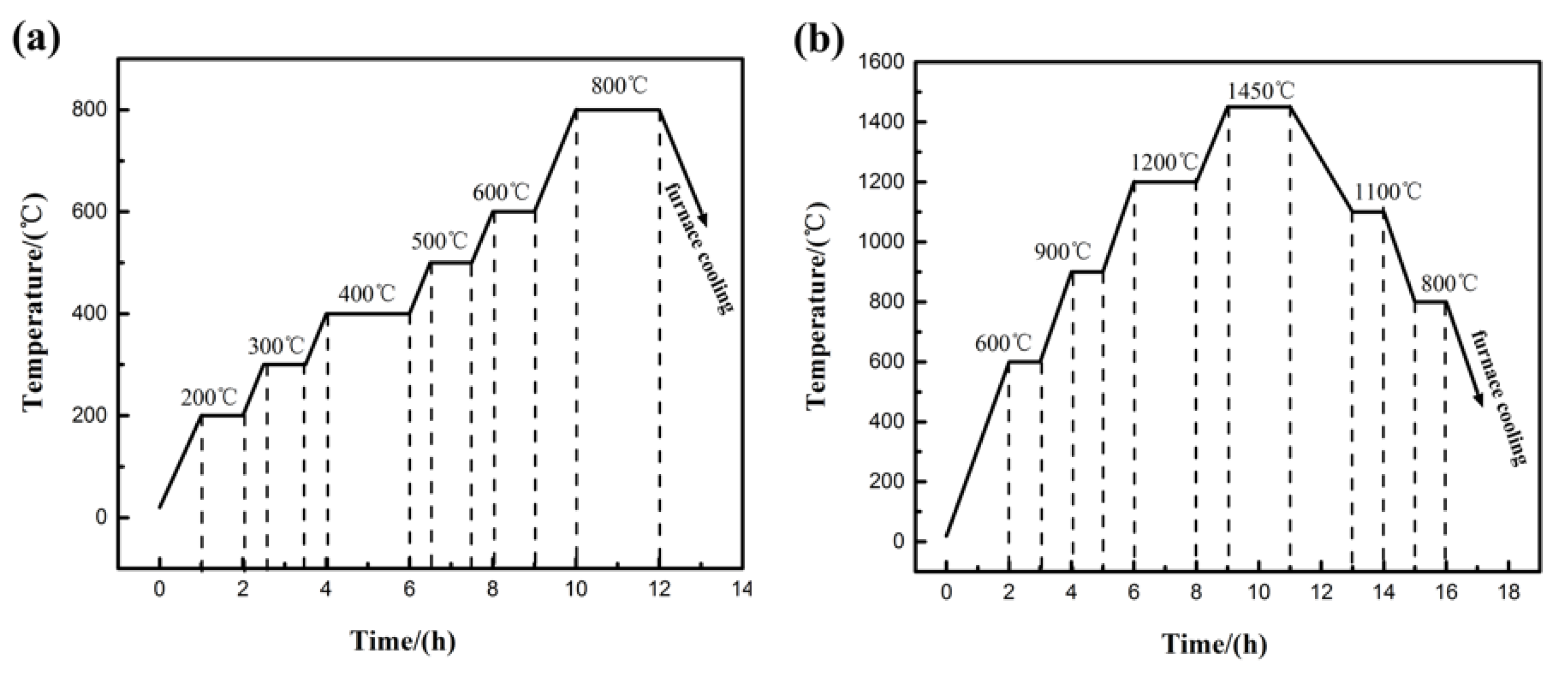

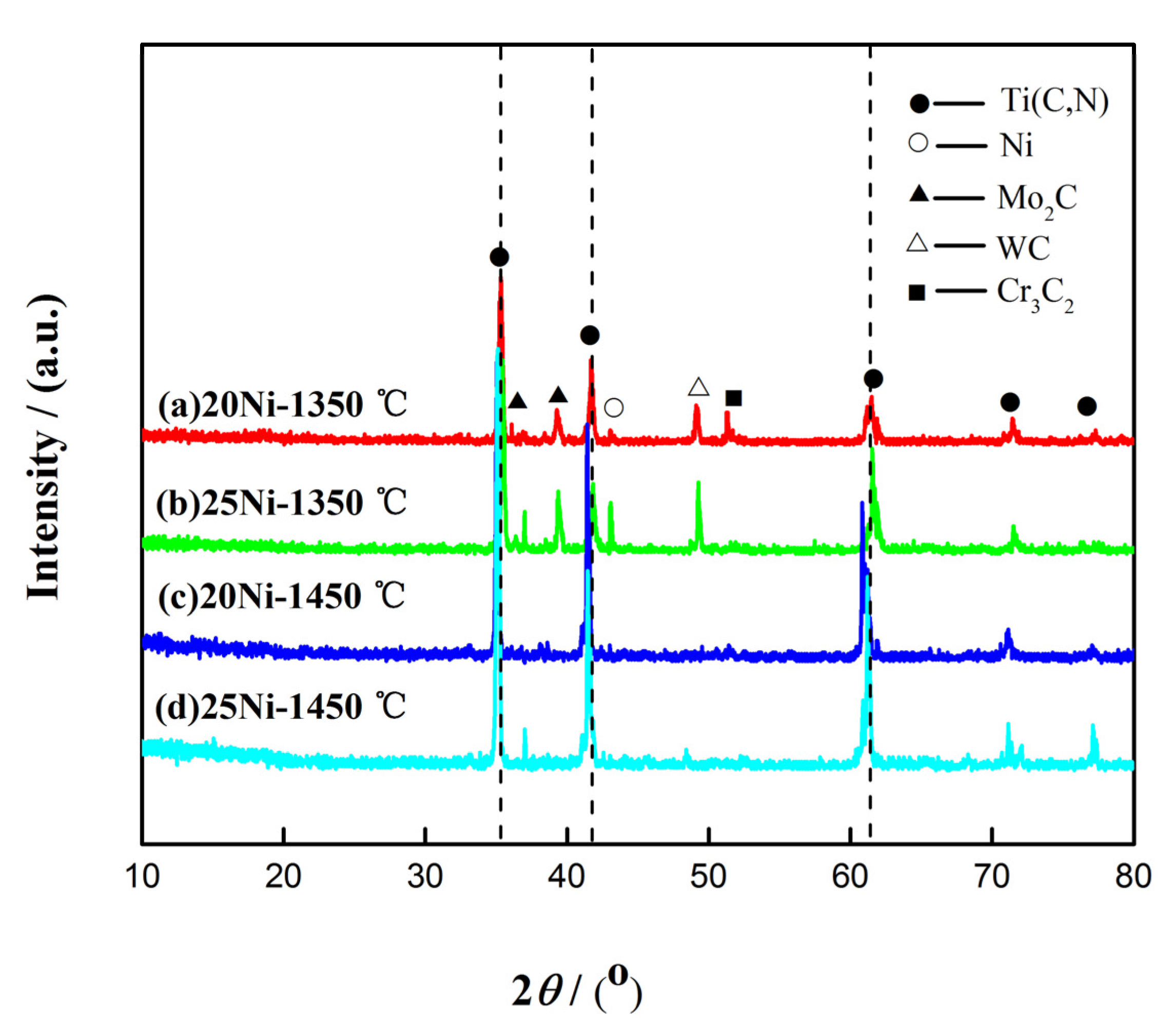
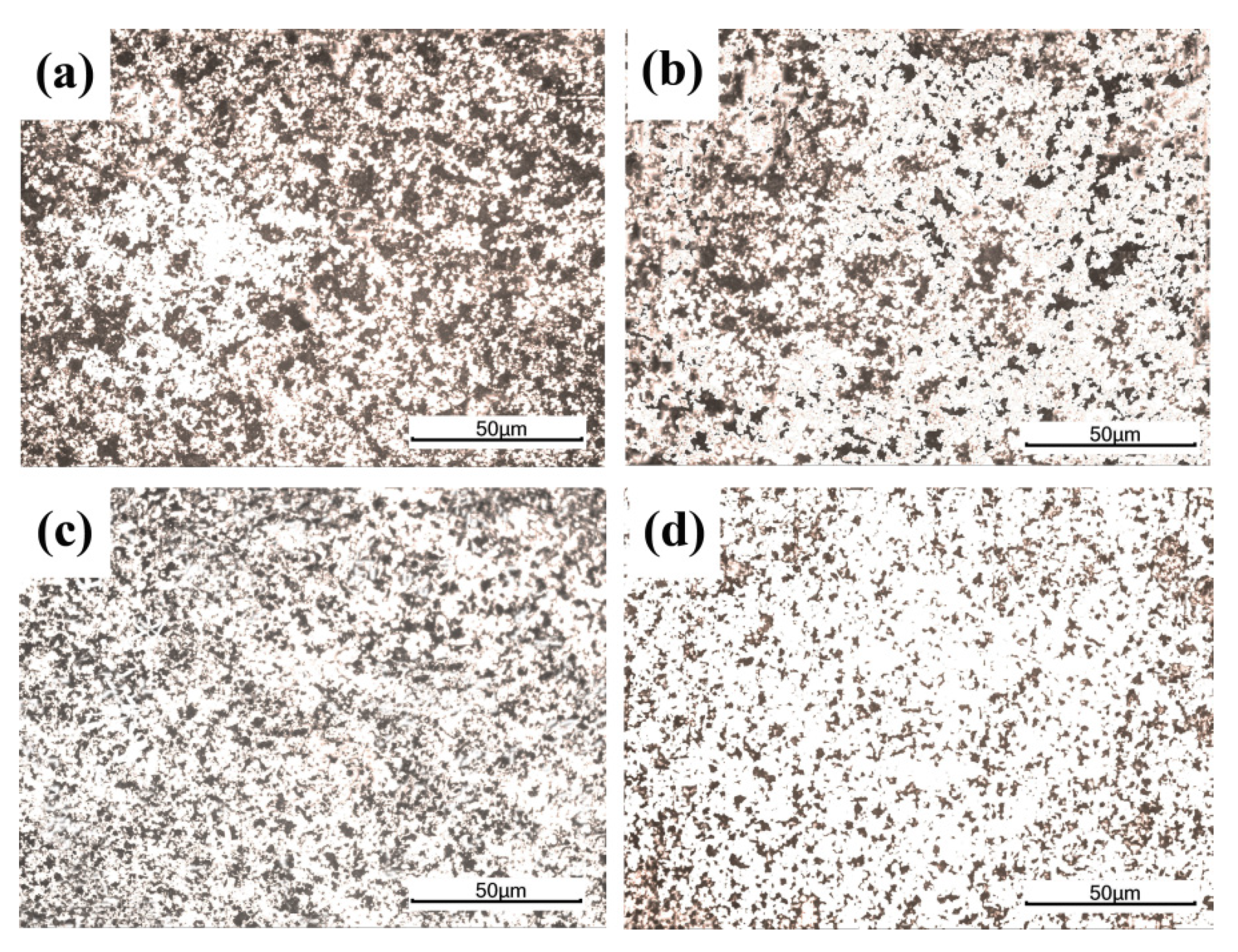
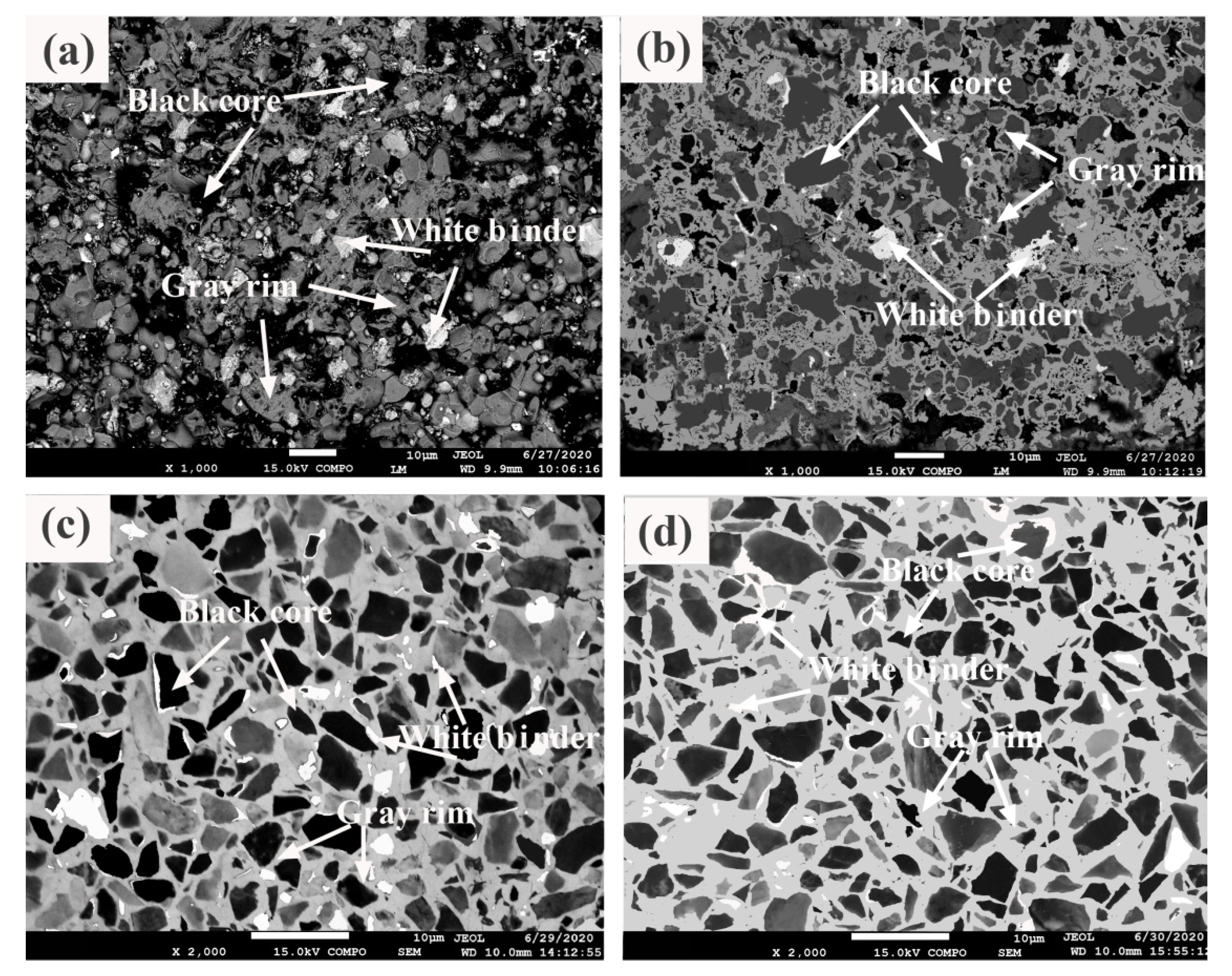
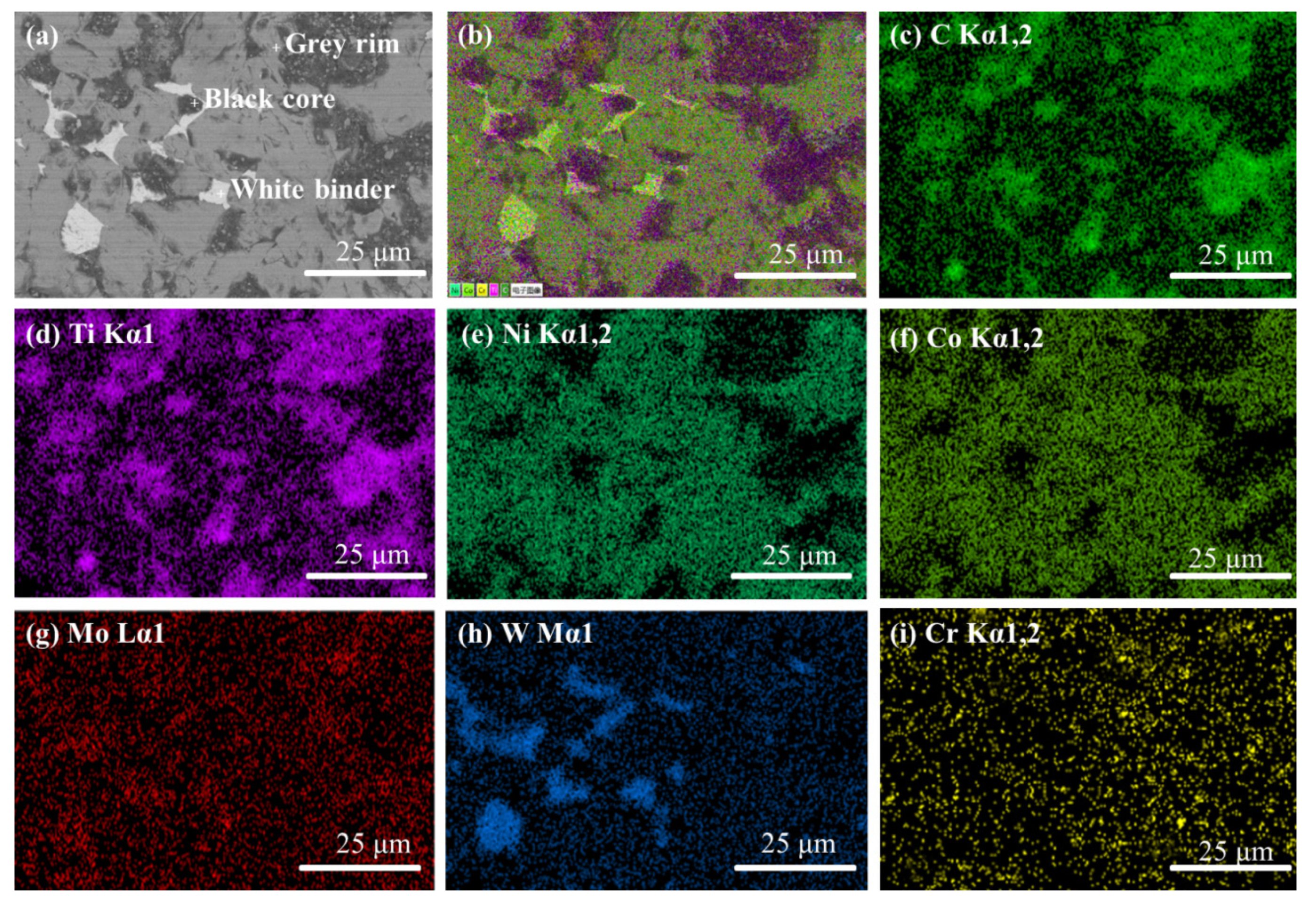

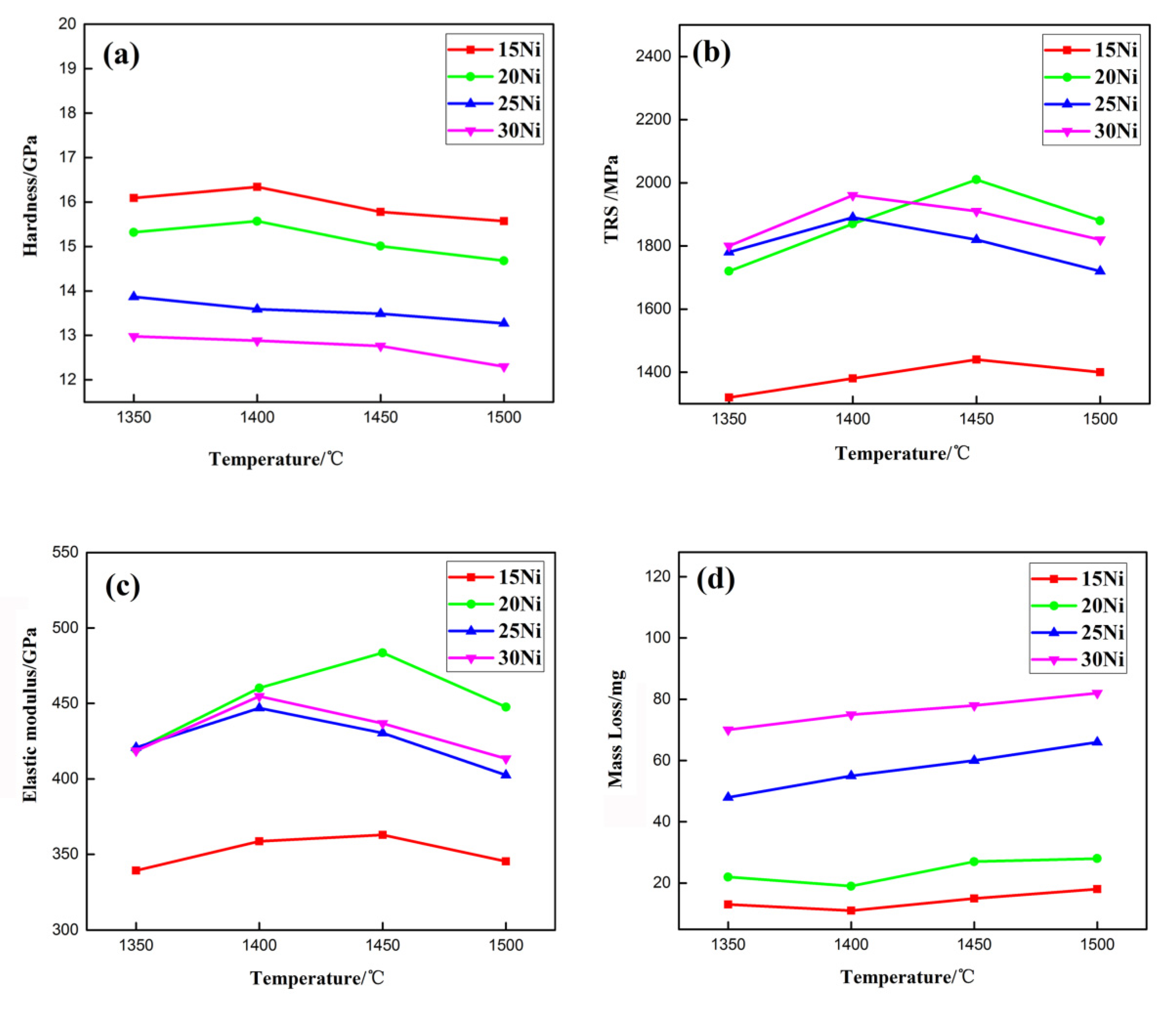
| Powders | Purity (%) | Size (μm) | Manufacturer |
|---|---|---|---|
| TiC | ≥99.0 | 2.40 | Qinghe bodrill metal material Co., Ltd., Xingtai, China |
| TiN | ≥99.0 | 2.50 | Qinghe bodrill metal material Co., Ltd., Xingtai, China |
| Ni | ≥99.7 | 2.25 | Shanghai Yunfu Nanotechnology Co., Ltd., Shanghai, China |
| Co | ≥99.0 | 3.60 | Shanghai Yunfu Nanotechnology Co., Ltd., Shanghai, China |
| Mo | ≥99.9 | 2.30 | Shanghai Yunfu Nanotechnology Co., Ltd., Shanghai, China |
| WC | ≥99.9 | 3.40 | Qinghe bodrill metal material Co., Ltd., Xingtai, China |
| Cr3C2 | ≥99.0 | 2.30 | Qinghe bodrill metal material Co., Ltd., Xingtai, China |
| C | ≥99.8 | 3.50 | Qinghe bodrill metal material Co., Ltd., Xingtai, China |
| Samples | Density (g/cm3) | Manufacturer |
|---|---|---|
| Paraffin wax | 0.82 | Aladdin Chemistry Co., Ltd., Shanghai, China |
| Polyethylene glycol-2000 (PEG-2000) | 1.13 | Aladdin Chemistry Co., Ltd., Shanghai, China |
| Polyvinyl alcohol-1788 (PVA-1788) | 1.30 | Aladdin Chemistry Co., Ltd., Shanghai, China |
| Samples | TiC | TiN | Ni | Co | Mo | WC | Cr3C2 | C |
|---|---|---|---|---|---|---|---|---|
| 10Ni | 55 | 10 | 10 | 5 | 7 | 8 | 4 | 1 |
| 20Ni | 40 | 10 | 20 | 10 | 7 | 8 | 4 | 1 |
| 25Ni | 32.5 | 10 | 25 | 12.5 | 7 | 8 | 4 | 1 |
| 30Ni | 25 | 10 | 30 | 15 | 7 | 8 | 4 | 1 |
| Name | 1350 °C | 1400 °C | 1450 °C | 1500 °C |
|---|---|---|---|---|
| 10Ni | 10Ni-1350 °C | 10Ni-1400 °C | 10Ni-1450 °C | 10Ni-1500 °C |
| 20Ni | 20Ni-1350 °C | 20Ni-1400 °C | 20Ni-1450 °C | 20Ni-1500 °C |
| 25Ni | 25Ni-1350 °C | 25Ni-1400 °C | 25Ni-1450 °C | 25Ni-1500 °C |
| 30Ni | 30Ni-1350 °C | 30Ni-1400 °C | 30Ni-1450 °C | 30Ni-1500 °C |
| Cermets | 15Ni-1450 °C | 20Ni-1450 °C | 25Ni-1450 °C | 30Ni-1450 °C |
|---|---|---|---|---|
| Porosity | A08B06 | A06B06 | A04B04 | A02B02 |
| Element | Ti | C | Ni | Co | Mo | Cr | W | Total |
|---|---|---|---|---|---|---|---|---|
| Black core | 48.22 | 33.87 | 7.68 | 2.82 | 1.67 | 2.11 | 3.63 | 100 |
| Grey rim | 33.68 | 22.86 | 15.37 | 13.56 | 1.93 | 8.76 | 3.84 | 100 |
| White binder | 11.07 | 7.15 | 22.24 | 19.81 | 3.85 | 1.56 | 33.32 | 100 |
© 2020 by the authors. Licensee MDPI, Basel, Switzerland. This article is an open access article distributed under the terms and conditions of the Creative Commons Attribution (CC BY) license (http://creativecommons.org/licenses/by/4.0/).
Share and Cite
Wang, X.; Wang, Q.; Dong, Z.; Zhou, X.; Wang, X.; Zhang, B.; Meng, C. Microstructure and Mechanical Properties of Multicomponent Metal Ti(C,N)-Based Cermets. Metals 2020, 10, 927. https://doi.org/10.3390/met10070927
Wang X, Wang Q, Dong Z, Zhou X, Wang X, Zhang B, Meng C. Microstructure and Mechanical Properties of Multicomponent Metal Ti(C,N)-Based Cermets. Metals. 2020; 10(7):927. https://doi.org/10.3390/met10070927
Chicago/Turabian StyleWang, Xuelei, Qiufeng Wang, Zhaojun Dong, Xiaoqian Zhou, Xiaoliang Wang, Boyan Zhang, and Chao Meng. 2020. "Microstructure and Mechanical Properties of Multicomponent Metal Ti(C,N)-Based Cermets" Metals 10, no. 7: 927. https://doi.org/10.3390/met10070927
APA StyleWang, X., Wang, Q., Dong, Z., Zhou, X., Wang, X., Zhang, B., & Meng, C. (2020). Microstructure and Mechanical Properties of Multicomponent Metal Ti(C,N)-Based Cermets. Metals, 10(7), 927. https://doi.org/10.3390/met10070927





